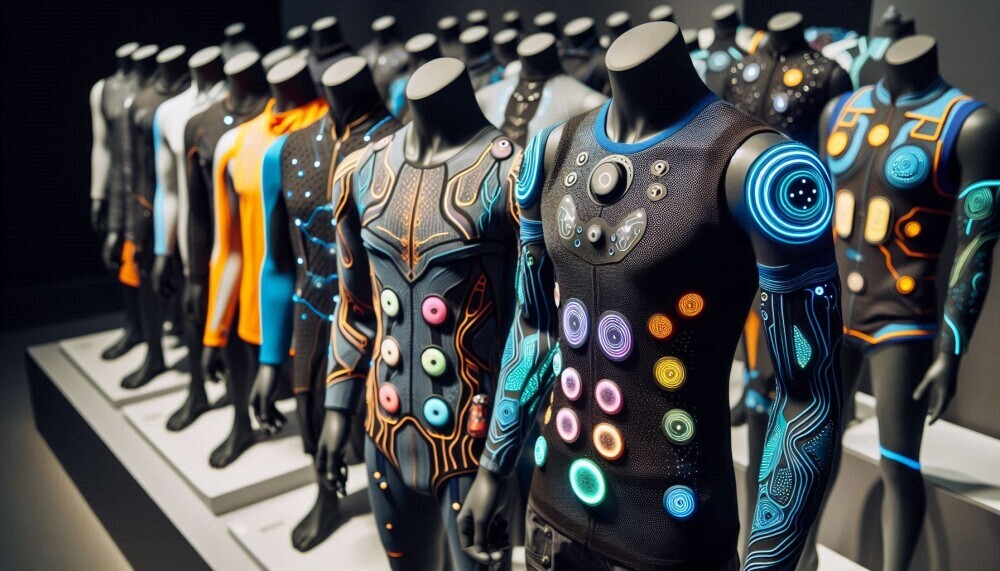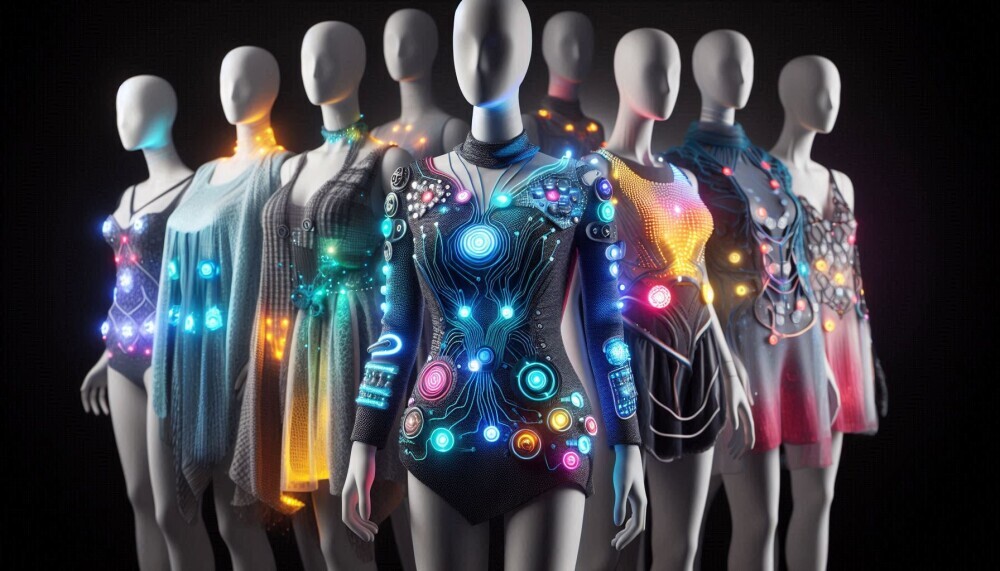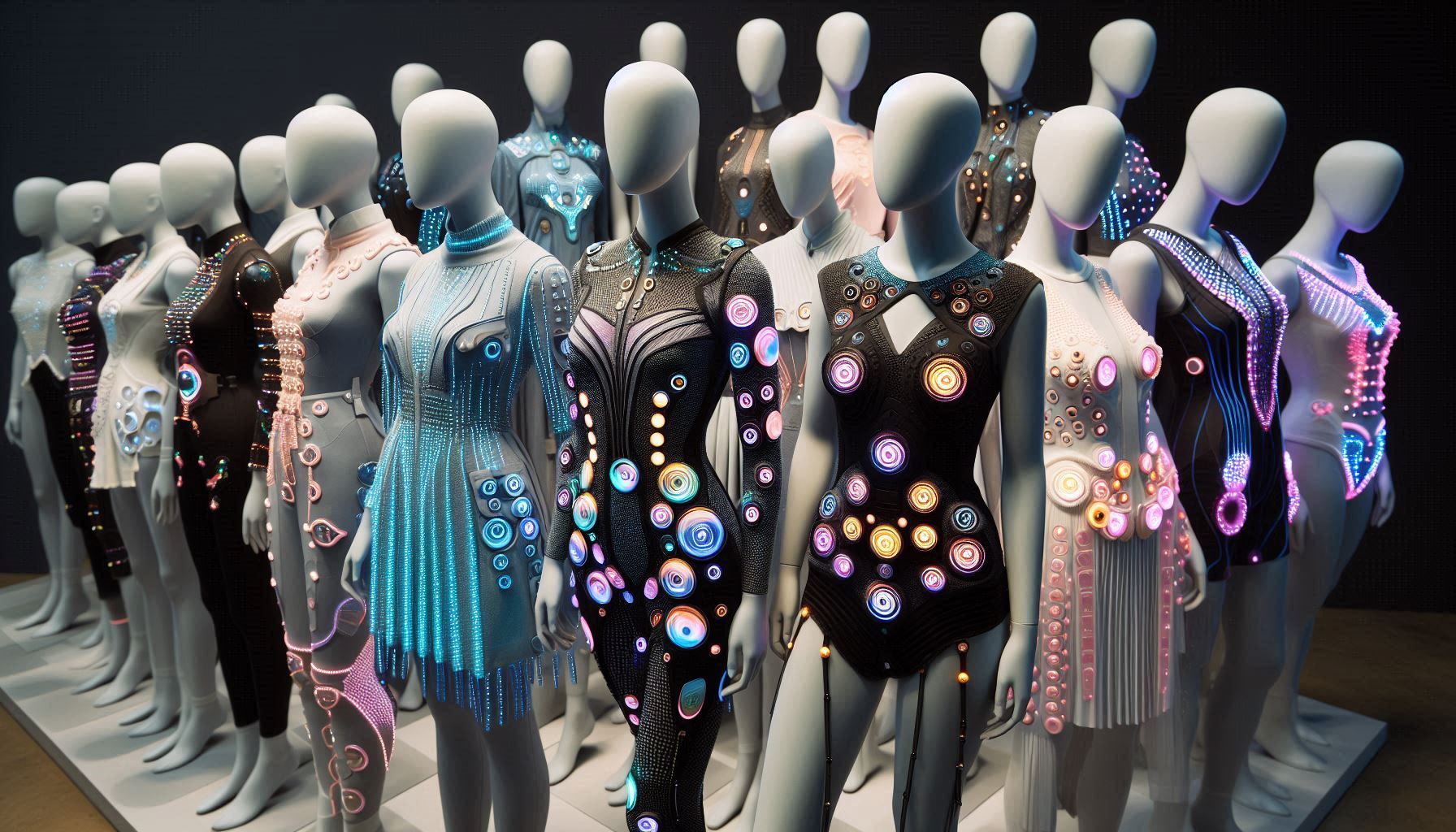E-Textile Sportswear: Monitoring Form, Heart Rate and Recovery. This is our topic for this article. E-textiles and smart textiles are beginning to enter the market now with increasing numbers of brands entering the fray. The market share for these products is forecast to be around $5.56 billion by 2030. This just reinforces the confidence behind these innovative products.


Introduction
Athletes and active people have always searched for ways to push their limits while protecting their bodies from injury. The rise of e-textiles is transforming that search into something far more precise and personalised. Instead of strapping on bulky fitness devices, athletes can now slip into sports clothing that looks and feels like standard performance gear but is embedded with sensors that track movement, heart rate, and recovery in real time. This shift is not just about convenience but about accuracy and integration into natural training routines.
E-textile sports wear blends advanced fabrics with tiny electronic components to create intelligent garments that collect detailed physiological and biomechanical data. This data can guide everything from the number of reps in a set to the depth of recovery between workouts. Whether you are a professional athlete chasing peak performance or a recreational runner wanting to improve form, e-textile clothing offers an entirely new level of feedback without interrupting the rhythm of your training.
What is E-textile sports wear
E-textile sports wear refers to clothing made from fabrics interwoven with conductive threads, flexible sensors, and small electronic modules. These garments are designed to monitor body metrics while being as comfortable and lightweight as traditional sports apparel. Unlike wearable gadgets that attach externally, e-textile garments integrate the technology directly into the fabric so the monitoring happens seamlessly during your activity.
Sensors may detect muscle activation, body posture, joint angles, heart rate, breathing patterns, or even muscle fatigue. The readings are transmitted to an app or display in real time so the athlete can adjust form, pacing, or intensity instantly. As the sensors are placed exactly where needed and remain stable during movement, the accuracy can be higher than wrist worn or clip on devices.
Key features of e textile sports wear
Features to look for in e-textile sports wear
• Real time heart rate monitoring with accurate chest or torso contact
• Motion tracking for running form, cycling posture, or weightlifting technique
• Muscle activity sensing for identifying imbalances or underuse
• Breathable, sweat wicking fabrics for comfort during high intensity sessions
• Washable designs with removable electronics
• Long battery life for full day training or competitions
• Companion app with detailed post session analytics and recovery insights
• Alerts for overtraining, poor form, or unusual heart patterns
How it works
E-textile garments achieve their monitoring abilities by weaving conductive fibres into specific areas of the clothing. For example, a running shirt might have sensor panels across the chest and upper back to capture heart rate and breathing rhythm. Leggings for cyclists could contain sensors along the thighs and calves to measure muscle activation timing. A small processing unit, usually located in a pocket or snap on module, collects the sensor data and transmits it via Bluetooth to a paired phone, smartwatch, or training computer.
Advanced software interprets the data into easy to read metrics. Motion tracking is often powered by embedded accelerometers and gyroscopes that detect movement patterns. Heart rate and muscle signals are collected using bioelectric sensors similar to those in medical grade monitoring equipment but made flexible and comfortable enough for sports use.
What can be measured?
Common measurements in e-textile sports wear
• Heart rate and heart rate variability
• Breathing rate and breathing depth
• Running stride length, cadence, and symmetry
• Cycling posture and pedal stroke balance
• Muscle activation timing and intensity
• Calorie burn estimates and energy expenditure
• Recovery metrics including muscle fatigue indicators
• Body temperature trends during exertion
Benefits for athletes and active users
Precision training feedback
Real time monitoring allows athletes to correct form before bad habits become ingrained. Subtle adjustments to running stride or lifting posture can reduce injury risk.
Better recovery planning
Heart rate variability and muscle fatigue readings help determine when to rest and when to push harder, reducing the risk of overtraining.
Comfort and integration
Because the sensors are in the fabric, athletes do not need to remember to strap on extra gadgets or adjust for discomfort mid workout.
Performance tracking over time
Consistent and accurate measurements allow for better tracking of progress, making it easier to identify which training strategies are working.
Injury prevention
Early detection of imbalances or excessive strain on certain muscles can prompt corrective exercises before an injury develops.
Pros and cons
Pros
• Seamless integration into sports clothing
• High accuracy from stable sensor placement
• Measures both performance and recovery indicators
• Real time data for immediate feedback
• Suitable for a range of sports and activities
Cons
• Higher cost than traditional sports wear
• Battery charging and occasional maintenance needed
• Fit must be precise for accurate data
• Requires a companion device to view results
• Durability may vary with washing frequency
Price ranges and ongoing costs
E-textile sports wear varies widely in price depending on complexity and sport specificity.
• Basic heart rate monitoring shirts start around £100 to £150
• Multi sensor garments for running or cycling analysis range from £200 to £400
• High end full body monitoring systems for elite training can exceed £600
Some brands charge extra for premium app features, cloud storage of training history, or advanced analytics. Subscription costs can range from £5 to £20 per month. It is worth checking if the core features you need are included without a subscription.
Who should use e-textile sports wear
Best suited for
• Competitive athletes aiming to refine technique and monitor recovery closely
• Recreational runners or cyclists wanting form feedback without extra devices
• Sports teams using performance tracking to improve training efficiency
• Fitness enthusiasts looking for data driven insights to prevent injury
• Coaches and physiotherapists assessing form and rehabilitation progress
Less suitable for
• Casual exercisers who prefer minimal tech integration
• Individuals sensitive to fabric compression or snug fits
• Those without access to a compatible smartphone or device
How to get the best from your wearable
Tips for effective use
• Choose the right garment size for optimal sensor contact
• Wear the garment during both training and recovery sessions to capture full data
• Follow washing and care instructions to maintain sensor accuracy
• Review post session analytics to identify trends rather than focusing on single workouts
• Use the feedback to adjust form and training load gradually
• Pair the data with proper nutrition, hydration, and rest for balanced performance gains
Data interpretation and coaching
For athletes new to performance metrics, it is important to learn what the numbers mean. A coach or sports physiologist can help translate readings into actionable advice. For example, high variability in stride symmetry may indicate uneven muscle strength, prompting targeted strength training. A drop in heart rate variability over several days could signal the need for lighter workouts or more rest.
Care and durability
While most e-textile garments are washable, the electronics must usually be removed before washing. Cool water, gentle detergents, and air drying are best to preserve both the fabric and the sensors. Avoid stretching or wringing the sensor areas, and store the garment flat when not in use.
Privacy considerations
Since these garments collect sensitive health and performance data, look for clear privacy policies from the manufacturer. Choose systems that allow you to control data sharing and export your records if you change platforms or coaching services.
Frequently asked questions
1. Is e-textile sports wear comfortable for long workouts
Yes, most garments are made from lightweight, breathable fabrics similar to premium sports wear. After a short adjustment period, most users find them as comfortable as regular gear.
2. Can I wash e-textile sports wear like normal clothes
Yes, but remove any detachable electronics first and follow the care instructions carefully to maintain performance.
3. Do I need a smartphone to use it
A smartphone or compatible training device is required to set up the garment and view data. Some systems can display basic metrics on compatible watches or cycling computers.
4. How accurate are the measurements
Heart rate and motion tracking can be very accurate when the garment fits correctly. Accuracy can drop if the sensors lose contact with the skin.
5. Will it replace my existing fitness tracker
It can for certain measurements, especially heart rate and form tracking. However, some users combine it with GPS watches or other devices for location based data.
6. Is it worth the cost for non professional athletes
If you value detailed feedback on form, recovery, and performance, it can be worth the investment even for recreational athletes. For casual users, simpler devices may be sufficient.
The future of e-textile sports wear
Research is moving towards even more integrated fabrics with self charging capabilities and automatic calibration. Future garments may adapt compression or ventilation based on real time feedback from the sensors, offering personalised support throughout a workout.


Conclusion
E-textile sports wear is reshaping the way athletes train, recover, and prevent injuries. By embedding sensors directly into comfortable sports garments, it delivers high accuracy data without disrupting the natural flow of a workout. From monitoring heart rate to tracking posture and recovery, these garments put advanced sports science tools directly on your body.
While the technology comes at a higher cost and requires some care in use, its benefits for performance optimisation and injury prevention are substantial. Choosing the right garment, wearing it consistently, and acting on the insights it provides can lead to measurable improvements in both form and fitness. Whether you are chasing a personal best or simply looking to train smarter, e-textile sports wear offers a seamless way to connect your body’s signals to your performance goals.
Our Thanks!
Many thanks to you for reading this article on E-Textile Sportswear: Monitoring Form, Heart Rate And Recovery. This is an interesting topic as it’s still quite new to the market and will be constantly evolving as things move forwards. Why not take a look at one of our related articles on this subject? It’s titled Smart Textiles And E-Textiles: The Next Frontier In Wearable Health Tech.
Please let us know in the comments which type of wearable health tech device you are currently using or plan to buy in the future! The comments section is just underneath this article!
**Here is a bit of transparency. Our website www.vertevia.com does contain affiliate links and Amazon links. So, if you did make a purchase through the website, we may receive a small commission. This is at no extra cost to you whatsoever. It’s just a way for you to support us as we continue to bring you top quality content**
All the best!
Eamon

